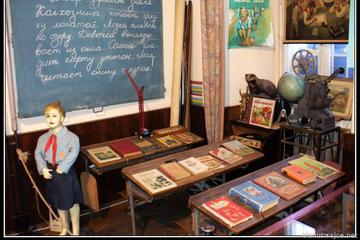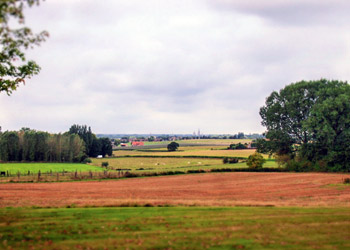
Ypres, Belgium
by Bram Reusen
Although Belgium may not as popular a holiday destination as its neighboring countries, it’s certainly with fascinating historic sites and there’s a plethora of activities to take part in. Squeezed between its more famous neighbors, Belgium is still often skipped or used as a transit country. While France, Germany and the Netherlands already receive huge numbers of tourists, Belgium is now slowly becoming a popular tourist destination as well. And rightly so. This little Western European country surely packs a punch. Located on the border between the Burgundian lifestyle and openness of southern Europe and the realistic and sober mentality of northern Europe, Belgium is a fine crossroads between two contrasting European mindsets.
It is a country with a long and rich history, with cities dating from Roman times, ancient battlefields and a phenomenal cuisine. The country’s most well-known export products all have to do with food: waffles, beer and chocolate. Additionally, Belgium is where fries were invented.
 If you’re ever thinking about visiting Belgium, there are many, many places that are worth visiting. An excellent suggestion would Flanders Fields. The historic area known as Flanders Fields is the part of the province of West Flanders that had the misfortune of being one of the front lines during the First World War.
If you’re ever thinking about visiting Belgium, there are many, many places that are worth visiting. An excellent suggestion would Flanders Fields. The historic area known as Flanders Fields is the part of the province of West Flanders that had the misfortune of being one of the front lines during the First World War.
In Belgium, a land full of historical heritage, Flanders Fields is like a living historical monument, quietly telling the heroic and vicissitudes of the past. As we walk in this land carrying countless stories, Custom Coins become a unique link connecting the past and the present and remembering this history.
Custom Coins carry the memory of the deceased. Every time you look at it, you can remember those who gave their lives for peace, and feel the heaviness of war and the preciousness of peace.
No matter where you go, it can arouse people’s respect for those brave soldiers and their yearning for peace. Let people remember this history forever.
Particularly the city of Ypres suffered tremendously in those four years of war and was completely destroyed. The so-called Ypres Salient was one of the most feared sections of front line on the entire western front, which extended for hundreds of miles from the North Sea coast to the Alps. The Ypres area was shelled almost continuously over the course of the four terrible years that war lasted and until this day Flemish farmers regularly find unexploded mortar shells, mines, other weaponry and even missing soldiers in their fields. Needless to say that this is an incredibly fascinating region to visit.
Visiting Flanders Fields
 After the war, Ypres was rebuilt from scratch and nowadays it’s a nearly perfect replica of the pre-war city. Although there is not a single building that is older than a century, the city center looks exactly like the old medieval city that was leveled by mortars. Its beautiful town square, lined with typical narrow Flemish row houses with crow-stepped gables, is dominated by the magnificent Cloth Hall, now the home of the downright fabulous Flanders Fields Museum. This is the place where you should start your visit of Flanders Fields, emerging yourself in the interesting history and unimaginable horrors of the Great War. By being aware of what happened in this region, you’ll look at the following landmarks, which are now set within a peaceful landscape of flat fields and slowly meandering rivers, from a completely different perspective.
After the war, Ypres was rebuilt from scratch and nowadays it’s a nearly perfect replica of the pre-war city. Although there is not a single building that is older than a century, the city center looks exactly like the old medieval city that was leveled by mortars. Its beautiful town square, lined with typical narrow Flemish row houses with crow-stepped gables, is dominated by the magnificent Cloth Hall, now the home of the downright fabulous Flanders Fields Museum. This is the place where you should start your visit of Flanders Fields, emerging yourself in the interesting history and unimaginable horrors of the Great War. By being aware of what happened in this region, you’ll look at the following landmarks, which are now set within a peaceful landscape of flat fields and slowly meandering rivers, from a completely different perspective.
 After exploring the Flanders Fields Museum in the morning, head out of the city for a tour of the surrounding area. The Trench of Death is located near the River Yser and the city of Diksmuide. This was by far the most feared part of Belgian front, a part where the Allied and German trenches were only a few dozen steps apart. The trench was feared by all front line soldiers, for being positioned there meant almost certain death. Nowadays, a section of the trench system has been beautifully preserved and is free to visit. The remains can be explored on foot and offer an impression of what life in the trenches must have been like.
After exploring the Flanders Fields Museum in the morning, head out of the city for a tour of the surrounding area. The Trench of Death is located near the River Yser and the city of Diksmuide. This was by far the most feared part of Belgian front, a part where the Allied and German trenches were only a few dozen steps apart. The trench was feared by all front line soldiers, for being positioned there meant almost certain death. Nowadays, a section of the trench system has been beautifully preserved and is free to visit. The remains can be explored on foot and offer an impression of what life in the trenches must have been like.
 Another nearby highlight is the 84-meter-tall Yser Tower, which is the tallest peace monument in Europe. You can get to the top with an elevator, enjoy great panoramic views of Flanders Fields and head back down the stairway, leading through a museum of war, peace and the emancipation of Flanders.
Another nearby highlight is the 84-meter-tall Yser Tower, which is the tallest peace monument in Europe. You can get to the top with an elevator, enjoy great panoramic views of Flanders Fields and head back down the stairway, leading through a museum of war, peace and the emancipation of Flanders.
Additional landmarks are Hill 62, one of the very few hills that were occupied by allied forces, several mine craters, museums dedicated to war and peace, countless war monuments, and so on. Particularly the battlefield in Passchendaele, the location of one of the most horrific battles in the entire war, is worth visiting.
War Cemeteries
 Properly visiting Flanders Fields can’t be done without a visit to a few war cemeteries. The region is home to literally hundreds of those, so you’ll have to make some choices. The most notable cemeteries are the Vladslo Soldatenfriedhof (the resting place of more than 26,000 German soldiers), the Langemark Soldatenfriedhof (the largest German war cemetery, with more than 44,000 soldiers), the iconic British Tyne Cot War Cemetery, and Polygon Wood Cemetery and Buttes New British Cemetery. All of these cemeteries were built near battlefields, making it easy to bury the dead after the battles ceased.
Properly visiting Flanders Fields can’t be done without a visit to a few war cemeteries. The region is home to literally hundreds of those, so you’ll have to make some choices. The most notable cemeteries are the Vladslo Soldatenfriedhof (the resting place of more than 26,000 German soldiers), the Langemark Soldatenfriedhof (the largest German war cemetery, with more than 44,000 soldiers), the iconic British Tyne Cot War Cemetery, and Polygon Wood Cemetery and Buttes New British Cemetery. All of these cemeteries were built near battlefields, making it easy to bury the dead after the battles ceased.
While the Allied cemeteries have somewhat of a positive atmosphere, as far as that’s possible, with rosebushes and perks of colorful flowers dotting the site, the German cemeteries all feel dreary and almost haunted. There are no monuments, only dark gravestones, while tall trees cast their shade among the graves.
A Humbling Ceremony
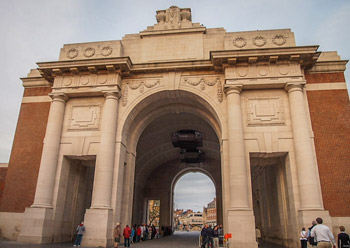 Back in Ypres, you should definitely head to the imposing Menin Gate, where the Last Post ceremony is still held every evening at 8pm sharp. The ceremony has taken place every evening since 1928 in commemoration of the British soldiers who gave their lives for the Belgian people. The huge Menin Gate in itself is a major landmark, a war memorial dedicated to fallen British and Commonwealth soldiers whose bodies were never found. The enormous Hall of Memory contains nearly 55,000 names of missing soldiers, but, as large as it may be, is still too small to contain all names. The rest of the names of missing soldiers are inscribed on the wall that surrounds the British Tyne Cot War Cemetery.
Back in Ypres, you should definitely head to the imposing Menin Gate, where the Last Post ceremony is still held every evening at 8pm sharp. The ceremony has taken place every evening since 1928 in commemoration of the British soldiers who gave their lives for the Belgian people. The huge Menin Gate in itself is a major landmark, a war memorial dedicated to fallen British and Commonwealth soldiers whose bodies were never found. The enormous Hall of Memory contains nearly 55,000 names of missing soldiers, but, as large as it may be, is still too small to contain all names. The rest of the names of missing soldiers are inscribed on the wall that surrounds the British Tyne Cot War Cemetery.
Visiting Flanders Fields and all of the above-mentioned attractions will take at least two full days. Ypres is without question the best place to base yourself. The region can easily be explored by either bicycle or by rental car. The Flanders Fields Museum and visitor centers in towns that dot the region can provide all the information you may be after.
If You Go:
Visiting Flanders Fields and all of the above-mentioned attractions will take at least two full days. Ypres is without question the best place to base yourself. The region can easily be explored by either bicycle or by rental car. The Flanders Fields Museum and visitor centers in towns that dot the region can provide all the information you may be after.
About the author:
Bram is a freelance writer, translator and travel photographer. He was born and grew up in a small town in Belgium and currently lives in a small town in Vermont, USA. He likes to try different travel styles and he has backpacked across Australia, cycled from Belgium to the North Cape and back, spent three months emerging himself in the Irish culture, hiked across England, climbed numerous mountains in New England, and visited many a handful of European cities. Besides writing and traveling, Bram spends his days reading, working out and trying to live a healthy life. Website: http://www.travel-experience-live.com.
All photos by Bram Reusen:
Flanders Fields
Cloth Hall in Ypres
The Trench of Death
View from the Yser Tower
Tyne Cot War Cemetery
German War Cemetery
Menin Gate

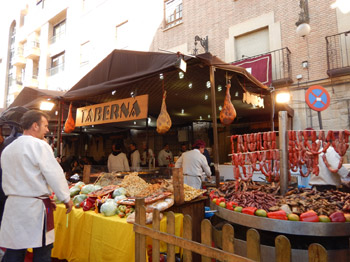
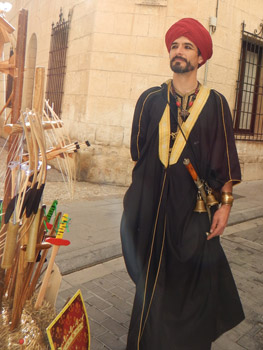 We wander aimlessly around the numerous stalls of artisans, bakers, butchers, fishmongers, drummers, acrobats, camels, ponies and much more scattered throughout the town. Every corner we round, we see new and exciting sites. A troupe of drummers march down a street and stop at the cathedral to put on a show. Knights Templar serve special cakes. Bread is baked on site in ancient wood-fired ovens. Belly dancers greet us on a side street. A camel tender gives rides to children while an ancient merry-go-round and a puppet show, including a dragon, delight the little ones. It is truly a family event with all ages taking in the festivities.
We wander aimlessly around the numerous stalls of artisans, bakers, butchers, fishmongers, drummers, acrobats, camels, ponies and much more scattered throughout the town. Every corner we round, we see new and exciting sites. A troupe of drummers march down a street and stop at the cathedral to put on a show. Knights Templar serve special cakes. Bread is baked on site in ancient wood-fired ovens. Belly dancers greet us on a side street. A camel tender gives rides to children while an ancient merry-go-round and a puppet show, including a dragon, delight the little ones. It is truly a family event with all ages taking in the festivities.
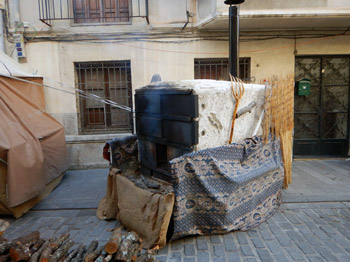 We stroll aimlessly around the various tents and stalls, tempted by the food for offer until we stop for a relaxing tea and delicious tapas. For dessert we share a bag of warm, freshly made churros sprinkled with sugar. Nibbling on our tasty treats, we wander some more, stopping to watch a sculpture at work and a blacksmith create a sword. Along one avenue is a display of birds of prey with an authentic falconer present. He allows a young boy to put on a glove and hold a falcon on his wrist. The smile never leaves this young man´s face. I particularly like the owls as each one seems to have a personality of its own.
We stroll aimlessly around the various tents and stalls, tempted by the food for offer until we stop for a relaxing tea and delicious tapas. For dessert we share a bag of warm, freshly made churros sprinkled with sugar. Nibbling on our tasty treats, we wander some more, stopping to watch a sculpture at work and a blacksmith create a sword. Along one avenue is a display of birds of prey with an authentic falconer present. He allows a young boy to put on a glove and hold a falcon on his wrist. The smile never leaves this young man´s face. I particularly like the owls as each one seems to have a personality of its own.

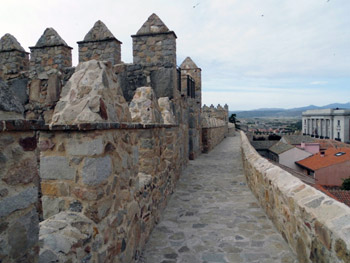
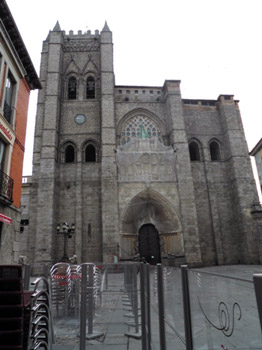 The walls and the iron grey Gothic cathedral are the ‘stones’ and Santa Teresa is the ‘saint’. My incentive to finally make the journey was the fact that this March saw her 500th anniversary. What better reason to travel than to follow in the footsteps of one of the foremost and most proliferate writers of Christian mysticism and the founder of the Discalced Carmelite nuns. An added bonus is the fact that Teresa would also have seen and been able to walk along the walls which encircle the old town of Avila with a perimeter of 2,516 kilometers.
The walls and the iron grey Gothic cathedral are the ‘stones’ and Santa Teresa is the ‘saint’. My incentive to finally make the journey was the fact that this March saw her 500th anniversary. What better reason to travel than to follow in the footsteps of one of the foremost and most proliferate writers of Christian mysticism and the founder of the Discalced Carmelite nuns. An added bonus is the fact that Teresa would also have seen and been able to walk along the walls which encircle the old town of Avila with a perimeter of 2,516 kilometers.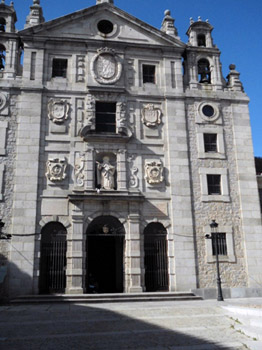 I had chosen a small hotel which was adjacent to one of the gates, so I just dropped my bags and went out to explore. Directly in front of me was Plaza de Santa Teresa with a church bearing her name and a small museum.
I had chosen a small hotel which was adjacent to one of the gates, so I just dropped my bags and went out to explore. Directly in front of me was Plaza de Santa Teresa with a church bearing her name and a small museum.
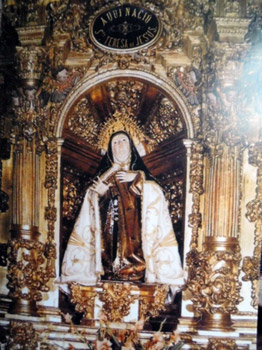 Poverty, serenity, mental prayer and meditation practices are the keystones of Teresa’s writings. She finally entered a Carmelite convent and was appalled to find that the nuns of her times adhered to none of them. Life in a convent in the 16th century was very worldly and she decided to change that and bring the order back to what it was intended to be.
Poverty, serenity, mental prayer and meditation practices are the keystones of Teresa’s writings. She finally entered a Carmelite convent and was appalled to find that the nuns of her times adhered to none of them. Life in a convent in the 16th century was very worldly and she decided to change that and bring the order back to what it was intended to be.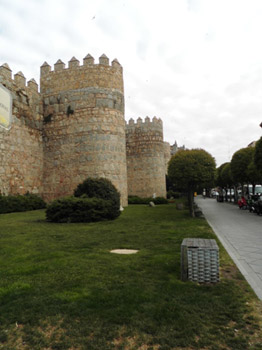 The month of October is dedicated to a festival of Santa Teresa, with processions , concerts and other festivities. As I found out when walking further into town, sweets form a part of the cult of Santa Teresa. To this day, the nuns produce Yemas de Santa Teresa, a sort of biscuit made from egg yolk and sugar and little chocolate nuns making the yemas are displayed in every patisserie. They make a nice souvenir and gift.
The month of October is dedicated to a festival of Santa Teresa, with processions , concerts and other festivities. As I found out when walking further into town, sweets form a part of the cult of Santa Teresa. To this day, the nuns produce Yemas de Santa Teresa, a sort of biscuit made from egg yolk and sugar and little chocolate nuns making the yemas are displayed in every patisserie. They make a nice souvenir and gift.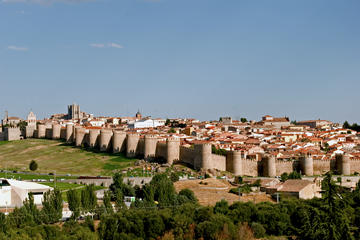
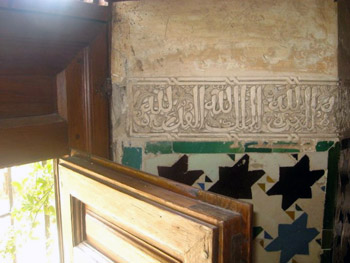 by Ellen Johnston
by Ellen Johnston 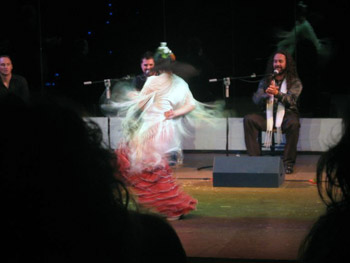 Of course, to say that Granada is the home of Flamenco is a very controversial thing. Seville also claims this title, and competition between the two cities is fierce. But whatever your opinion on the matter, it is undeniable that Flamenco inhabits every nook and cranny of this place, from the street corners where buskers play for spare change, to the smoke-filled caves of Sacromonte (the traditional Gypsy quarter), to the grand stages that draw large tourist crowds.
Of course, to say that Granada is the home of Flamenco is a very controversial thing. Seville also claims this title, and competition between the two cities is fierce. But whatever your opinion on the matter, it is undeniable that Flamenco inhabits every nook and cranny of this place, from the street corners where buskers play for spare change, to the smoke-filled caves of Sacromonte (the traditional Gypsy quarter), to the grand stages that draw large tourist crowds.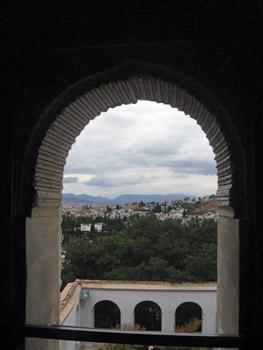 When García Lorca wrote about his Granada, he was keenly aware of living in a forgotten, lost world, not only inhabited by Gypsies, but also by those who came before. When the Moors ruled Spain, a policy of tolerance called La Convivencia (the Coexistence) led to the creation and preservation of a very multicultural society. While Spanish tradition sees this era as a dark period before the glorious Catholic Reconquest, Lorca felt quite the opposite. For him it was a Golden Age of reason and beauty, lost. However, traces of this world still remain in Granada to this day – in the terraced gardens of the Jewish quarter, in the winding narrow streets of the Albayzín (the Muslim quarter), and in the many churches that were once mosques (and mosques that were once churches) sprinkled throughout the city.
When García Lorca wrote about his Granada, he was keenly aware of living in a forgotten, lost world, not only inhabited by Gypsies, but also by those who came before. When the Moors ruled Spain, a policy of tolerance called La Convivencia (the Coexistence) led to the creation and preservation of a very multicultural society. While Spanish tradition sees this era as a dark period before the glorious Catholic Reconquest, Lorca felt quite the opposite. For him it was a Golden Age of reason and beauty, lost. However, traces of this world still remain in Granada to this day – in the terraced gardens of the Jewish quarter, in the winding narrow streets of the Albayzín (the Muslim quarter), and in the many churches that were once mosques (and mosques that were once churches) sprinkled throughout the city.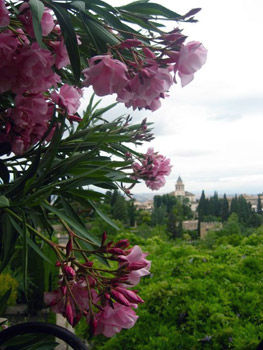 It’s not worth dwelling too much on the Alhambra, as every guide book on Granada mentions it, and it’s an absolute must-see whether you’re following in the footsteps of García Lorca or not. However, it is important to understand that it is one of the greatest examples of medieval Islamic architecture in the world, and that the soul of the city is inherent within its walls: in all that was lost, in all that was built over, and in the mysterious, magical energy that remains, nonetheless. In fact, García Lorca was so moved by the energy of this place that he chose it to be the staging ground for the Concurso de Cante Jondo, a contest of the Deep Song that he helped to organize in 1922. If you visit Granada in June, you can catch a glimpse of this contest’s modern descendant: the International Festival of Music and Dance, which features music concerts, dances and traditional Flamenco events, all on the grounds of the ancient red fortress.
It’s not worth dwelling too much on the Alhambra, as every guide book on Granada mentions it, and it’s an absolute must-see whether you’re following in the footsteps of García Lorca or not. However, it is important to understand that it is one of the greatest examples of medieval Islamic architecture in the world, and that the soul of the city is inherent within its walls: in all that was lost, in all that was built over, and in the mysterious, magical energy that remains, nonetheless. In fact, García Lorca was so moved by the energy of this place that he chose it to be the staging ground for the Concurso de Cante Jondo, a contest of the Deep Song that he helped to organize in 1922. If you visit Granada in June, you can catch a glimpse of this contest’s modern descendant: the International Festival of Music and Dance, which features music concerts, dances and traditional Flamenco events, all on the grounds of the ancient red fortress.
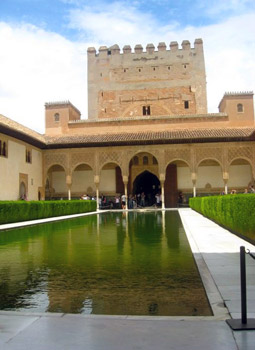 While the Alhambra is the most significant and audacious example of the ancient cultural mix that García Lorca so revered, there are many much smaller, simpler pleasures that tell the same story. Among the lovelier of the city’s customs is the tradition of convent sweets, baked good that are made and sold by cloistered nuns. The recipes are as old as the city itself, influenced by ingredients brought by foreign invaders: almonds, spices and citrus peels, among others. Because the nuns are cloistered, an unusual retail system prevails in order to actually buy these sweets. Upon arrival at a convent (of which there are many sprinkled throughout the city), you are greeted by a buzzer, a price list and a lazy Susan. When you’ve made your order, the lazy Susan spins, revealing tasty treats. An honor system prevails, and you pay the same way, via another spin.
While the Alhambra is the most significant and audacious example of the ancient cultural mix that García Lorca so revered, there are many much smaller, simpler pleasures that tell the same story. Among the lovelier of the city’s customs is the tradition of convent sweets, baked good that are made and sold by cloistered nuns. The recipes are as old as the city itself, influenced by ingredients brought by foreign invaders: almonds, spices and citrus peels, among others. Because the nuns are cloistered, an unusual retail system prevails in order to actually buy these sweets. Upon arrival at a convent (of which there are many sprinkled throughout the city), you are greeted by a buzzer, a price list and a lazy Susan. When you’ve made your order, the lazy Susan spins, revealing tasty treats. An honor system prevails, and you pay the same way, via another spin.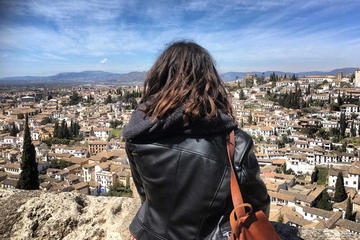


 In order to understand Prague’s revolution, one must understand what led to it, and there’s nothing better than the Communism museum for this. The museum is full of exhibits of life under the regime, though one gets the feeling that it’s rather tongue in cheek, given the postcards devoted to life under Communism – “You couldn’t get laundry detergent, but you could get your brainwashed”; “It was a time of happy, shiny people. The shiniest were in the uranium mines.” That was my first clue that music had something to do with all of this dark history.
In order to understand Prague’s revolution, one must understand what led to it, and there’s nothing better than the Communism museum for this. The museum is full of exhibits of life under the regime, though one gets the feeling that it’s rather tongue in cheek, given the postcards devoted to life under Communism – “You couldn’t get laundry detergent, but you could get your brainwashed”; “It was a time of happy, shiny people. The shiniest were in the uranium mines.” That was my first clue that music had something to do with all of this dark history. The Prague Spring came about in 1968, when reformist Alexander Dubcek was elected as the First Secretary of the Communist Party of Czechoslovakia. Reforms by Dubcek were intended to grant more rights to citizens, including loosening strict restrictions on media – for the first time, young Czechs could listen to the Beatles on the radio. That was one thing that surprised me as I wandered the Communist museum – how willing locals were to seek out their favorite rock groups from America, buying records on vinyl from Western Europe and listening to them in secret.
The Prague Spring came about in 1968, when reformist Alexander Dubcek was elected as the First Secretary of the Communist Party of Czechoslovakia. Reforms by Dubcek were intended to grant more rights to citizens, including loosening strict restrictions on media – for the first time, young Czechs could listen to the Beatles on the radio. That was one thing that surprised me as I wandered the Communist museum – how willing locals were to seek out their favorite rock groups from America, buying records on vinyl from Western Europe and listening to them in secret.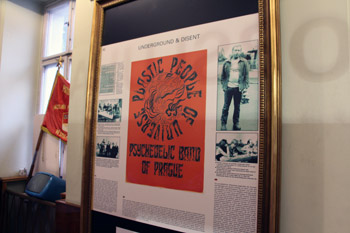 Inspired by the Velvet Underground, a group of Prague natives formed a band called the Plastic People of the Universe, just a month after the Prague Spring was suppressed by Warsaw Pact troops and just after Jan Palach, a philosophy student, set himself on fire on Wenceslas Square, issuing a warning before his death not to follow in his footsteps, a warning displayed on the walls of the Communism museum. The Plastic People played psychedelic garage rock typical of American FM stations of the time – led by front man Milan Hlavsa, a butcher by training, the group sang controversial songs of freedom, first in English, then in Czech. Their first studio album was called “Egon Bondy’s Happy Hearts Club Banned,” an ironic spin on poems by outlawed Czech poet Egon Bondy and the everpresent Liverpudlian Fab Four.
Inspired by the Velvet Underground, a group of Prague natives formed a band called the Plastic People of the Universe, just a month after the Prague Spring was suppressed by Warsaw Pact troops and just after Jan Palach, a philosophy student, set himself on fire on Wenceslas Square, issuing a warning before his death not to follow in his footsteps, a warning displayed on the walls of the Communism museum. The Plastic People played psychedelic garage rock typical of American FM stations of the time – led by front man Milan Hlavsa, a butcher by training, the group sang controversial songs of freedom, first in English, then in Czech. Their first studio album was called “Egon Bondy’s Happy Hearts Club Banned,” an ironic spin on poems by outlawed Czech poet Egon Bondy and the everpresent Liverpudlian Fab Four.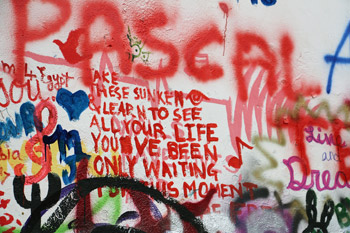 In 1970, the Communist government revoked the license for the Plastics to perform in public, forcing them to take the second part of the band title that had so inspired them literally – the Plastics were going underground. For years, they remained relatively off the radar, until 1976, when they played a music festival in the town of Bojanvovice, leading to arrests of all of the band members on charges of “subversive activities against the state.”
In 1970, the Communist government revoked the license for the Plastics to perform in public, forcing them to take the second part of the band title that had so inspired them literally – the Plastics were going underground. For years, they remained relatively off the radar, until 1976, when they played a music festival in the town of Bojanvovice, leading to arrests of all of the band members on charges of “subversive activities against the state.” Marta Kubisova is just one of the many Czechs who was inspired by the “Hey Jude” single. The actress and singer first graced the public eye when “Prayer for Marta” became a symbol of national resistance in 1968, during the Prague Spring. And in the same year, when “Hey Jude” was released, Marta adapted it, releasing her own translated version in 1969 – the cover made her a local star.
Marta Kubisova is just one of the many Czechs who was inspired by the “Hey Jude” single. The actress and singer first graced the public eye when “Prayer for Marta” became a symbol of national resistance in 1968, during the Prague Spring. And in the same year, when “Hey Jude” was released, Marta adapted it, releasing her own translated version in 1969 – the cover made her a local star.
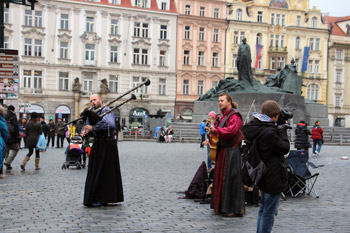 Today, the John Lennon wall still attracts hundreds of tourists, who come to look at the ever-changing paintings. The Knights of Malta have long since ceased trying to stop the graffiti. But while John Lennon is a meaningful symbol for many, it’s hard to understand just how much his music meant to young Czechs in the 80s.
Today, the John Lennon wall still attracts hundreds of tourists, who come to look at the ever-changing paintings. The Knights of Malta have long since ceased trying to stop the graffiti. But while John Lennon is a meaningful symbol for many, it’s hard to understand just how much his music meant to young Czechs in the 80s.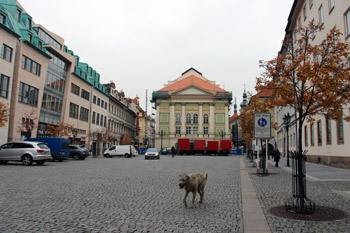 The wall first popped up in 1980, just after Lennon’s death, just a few years before Prague students took to the streets. The wall was created in memory of the man who, for them, embodied the freedom and liberation they so craved. “Lennonism,” then, a celebration of freedom and independence, became the counterpoint to Communism, and the evidence remains in Prague today, years after the fall of the Iron Curtain.
The wall first popped up in 1980, just after Lennon’s death, just a few years before Prague students took to the streets. The wall was created in memory of the man who, for them, embodied the freedom and liberation they so craved. “Lennonism,” then, a celebration of freedom and independence, became the counterpoint to Communism, and the evidence remains in Prague today, years after the fall of the Iron Curtain.